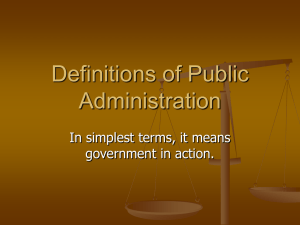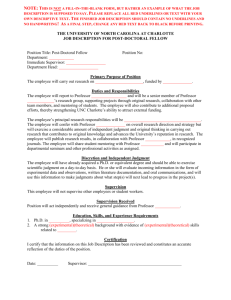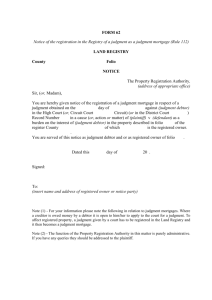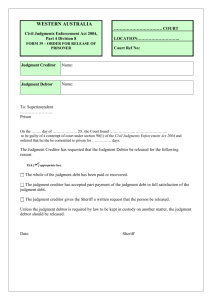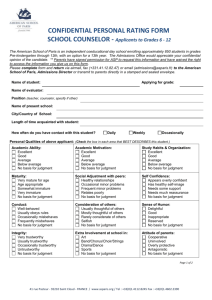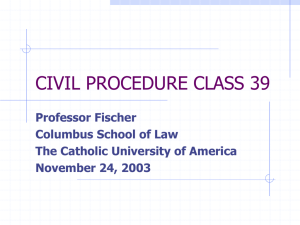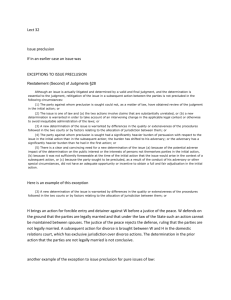Civil Procedure II -- Winter 2007 Essay Answer Outline
advertisement
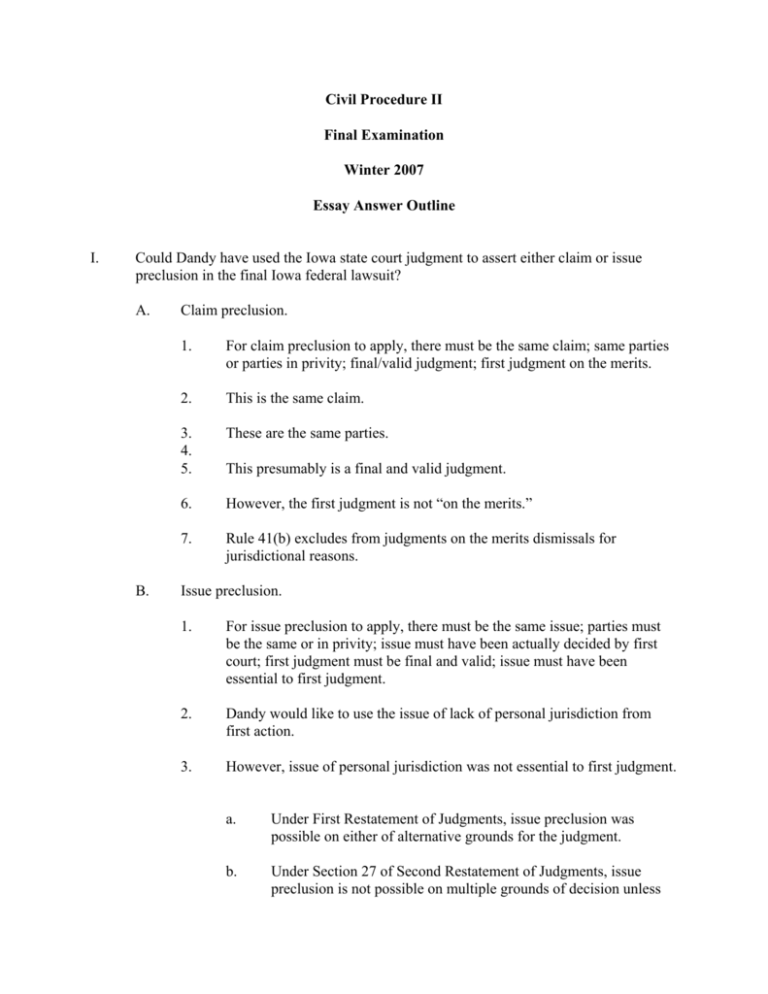
Civil Procedure II Final Examination Winter 2007 Essay Answer Outline I. Could Dandy have used the Iowa state court judgment to assert either claim or issue preclusion in the final Iowa federal lawsuit? A. B. Claim preclusion. 1. For claim preclusion to apply, there must be the same claim; same parties or parties in privity; final/valid judgment; first judgment on the merits. 2. This is the same claim. 3. 4. 5. These are the same parties. This presumably is a final and valid judgment. 6. However, the first judgment is not “on the merits.” 7. Rule 41(b) excludes from judgments on the merits dismissals for jurisdictional reasons. Issue preclusion. 1. For issue preclusion to apply, there must be the same issue; parties must be the same or in privity; issue must have been actually decided by first court; first judgment must be final and valid; issue must have been essential to first judgment. 2. Dandy would like to use the issue of lack of personal jurisdiction from first action. 3. However, issue of personal jurisdiction was not essential to first judgment. a. Under First Restatement of Judgments, issue preclusion was possible on either of alternative grounds for the judgment. b. Under Section 27 of Second Restatement of Judgments, issue preclusion is not possible on multiple grounds of decision unless 2 both grounds have been affirmed on appeal. II. 4. If personal jurisdiction were essential to first judgment, issue preclusion would be possible because the issue was the same; the parties were the same; first judgment was final and valid; and issue was actually decided in first case. 5. Under doctrine of full faith and credit as enunciated in 28 U.S.C. § 1738, Iowa federal court must give same full faith and credit to Iowa state court as would the rendering court. Could Dandy have used the Nebraska state court judgment to assert claim or issue preclusion in the final Iowa federal lawsuit? A. Claim preclusion. 1. For claim preclusion to apply, there must be the same claim; same parties or parties in privity; final/valid judgment; first judgment on the merits. 2. This is the same claim. 3. These are the same parties. 4. This presumably is a final and valid judgment. 5. a. In the federal system, judgment is considered final even though the first case is on appeal. b. Under Rule 60(b)(5), a judgment can be reopened if it is based upon a prior judgment that now has been reversed or otherwise vacated. Nebraska judgment is “on the merits.” a. Under Rule 37(d), Eileen’s action could be dismissed due to her failure to appear at her own deposition. b. She probably could have precluded questioning as to “why she and her lawyer” filed the lawsuit. (1) However, Rule 37(d) provides that – in order to assert this defense – Eileen had to file a motion for a protective order (rather than just not showing up). 3 c. B. C. III. Rule 41(b) provides that, unless court otherwise specifies, involuntary dismissals that are not for jurisdictional reasons or for not joining an indispensable party are “on the merits.” Therefore Nebraska judgment could have been used to successfully assert claim preclusion against Eileen. Issue preclusion. 1. For issue preclusion to apply, there must be the same issue; parties must be the same or in privity; issue must have been actually decided by first court; first judgment must be final and valid; issue must have been essential to first judgment. 2. There is no issue that was decided in Nebraska that would be helpful for Dandy to seek collateral estoppel on in the Iowa federal action. 3. While parties were the same and first judgment was a final and valid judgment, there is no issue that was actually decided and was essential to first judgment that would be useful to Danny in final lawsuit. 4. Under doctrine of full faith and credit as enunciated in 28 U.S.C. § 1738, however, Iowa federal court must give same full faith and credit to Nebraska state court as would the rendering court. Should the Iowa federal court have certified a class action in the final lawsuit? A. B. [Jurisdiction is presumed, do not consider the following: 1. Class action is possible under 28 U.S.C. § 1332. 2. Under Exxon v. Allapattah, jurisdiction is possible because Eileen satisfies amount in controversy and claims of other class members can be heard pursuant to 28 U.S.C. §1367. 3. Under Supreme Tribe of Ben Hur v. Cauble, only citizenship of named class representatives are considered in determining complete diversity. 4. Because it’s likely that no more than $5,000,000 is sought in damages, Class Action Fairness Act of 2005 (28 U.S.C. Section 1332(d)) does not apply.] Class actions can be certified pursuant to FRCP 23. 4 C. 1. All four requirements of Rule 23(a) must be satisfied. 2. Satisfaction of Rule 23(a) requirements: 3. Numerosity should be satisfied, because there apparently are 100s of class members. 4. There are many questions of law and fact common to all class members. 5. Typicality may be a problem because Eileen’s claim is for $100,000, while claims of many other class members may be only $100. 6. It's also unclear whether Eileen would fairly and adequately protect the interests of all other class members. a. Her attorney is a recent graduate of the University of Hawaii Law School. b. She already has file another claim that was dismissed due to lack of subject matter and personal jurisdiction. c. Eileen’s own interest in her $100,000 claim may make Eileen unlikely to fairly and adequately protect the interests of all other class members. One of three requirements of Rule 23(b) also must be satisfied. 1. There are no facts to suggest that individual actions would either (a) establish incompatible standards for defendants or (b) dispose of interests of other parties or substantially impair or impede their ability to protect their interests. 2. Class-wide injunctive or declaratory relief is not being sought. 3. Certification therefore must come under Rule 23(b)(3). a. Common questions of law or fact probably predominate over individual questions. b. Class action may be superior method for fair and efficient adjudication of the controversy. c. In making these determinations, court should apply 4 factors listed in Rule 23(b)(3). 5 d. 4. D. IV. V. Class members probably don't have particular interest in controlling their own litigation; there is no other litigation pending concerning this matter; it would make sense to concentrate all claims in this forum; and class action would probably be manageable. Perhaps subclasses could be certified in this case (as to either Iowa/Nebraska subclasses or to create subclasses for those claiming differing amounts of damages). Because this would be a Rule 23(b)(3) class, plaintiffs would be required to provide notice to class members. Was the Iowa federal judge correct in refusing to permit the expert to testify at trial? A. Expert should have been disclosed pursuant to Rule 26(a)(2). B. Expert also should have been listed in the Rule 16 final pretrial order. 1. Rule 16(e) provides: “The order following a final pretrial conference shall be modified only to prevent manifest injustice.” 2. Under Rule 16(f), court could sanction Dandy by refusing to permit his expert to testify at trial. 3. Another potential sanction would have been to permit expert to testify, but only after Eileen has had opportunity to depose expert–with costs covered by Dandy. Should the Iowa federal judge have granted the motion for judgment a matter of law? A. Judgment as a matter of law is provided for in Rule 50 of the Federal Rules of Civil Procedure. B. Motion for judgment as a matter of law has traditionally been referred to as a motion for a directed verdict. C. Motion for judgment as a matter of law was properly made at conclusion of all Eileen’s evidence (after she “has been fully heard” for purposes of Rule 50(a)(1)). 1. Motion should be granted if no reasonable jury could rule for Eileen. 6 2. VI. Motion should be granted if Eileen has not satisfied her burden of production. D. Credibility determinations are to be made by jury–not judge. E. Therefore court should not have granted motion for judgment as a matter of law. Extra Points. (2).



